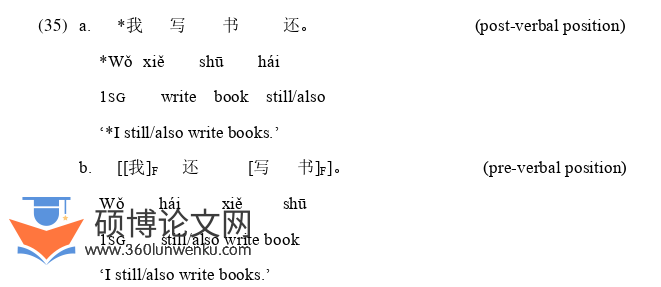本文是一篇语言学论文,本文认为,“还”有四类用法:添加用法、时间用法、程度用法以及反预期的用法。在添加用法中,“还”将一个新事件添加到话语中,新添加的事件与现有事件之间不存在量级关系。
CHAPTER ONE GENERAL INTRODUCTION
1.1 Preliminaries
Hái is always considered as an adverb with multi-functions, associated with scope and quantity, evaluation, time, and degree (Chao 1968), as exemplified below:
In addition to the additive use, the temporal use, the degree use, and the counterexpectation use mentioned above, scholars have also proposed other uses, such as moderate use, repetitive use, and continuative use etc.
Though the previous studies have offered a detailed classification and descriptions of hái, its core meaning and the relationship among the different uses have received little attention. This thesis provides a systematic analysis of the semantics of hái in terms of four uses: the additive use, the temporal use, the degree use, and the counterexpectation use. In addition, this thesis also provides a formal account of the semantic analysis of hái.

语言学论文怎么写
...........................
1.2 Research background
To date, extensive studies have been conducted to investigate the various semantic interpretations (Lü 1980; Li and Thompson 1981; Paris 1988; Yeh 1998; F.-H. Liu 2000; Gao 2002; Donazzan 2005; H. Liu 2009; Zhang and Lin 2016; Yang 2017; Y.-H. Chen 2018), whereas controversy arises pertaining to the classification of the various uses and the core meaning of hái. This section briefly reviews previous studies on hái in terms of its classifications and core meaning.
Many scholars have provided detailed classifications of the various uses of hái. As mentioned earlier, Chao (1968:780-787) divides hái into four uses: 1) the addition of the quantity or scope; 2) to express the speaker’s evaluation of a proposition; 3) a certain degree of the gradable adjective; and 4) to associate with time, denoting the meaning of the duration of the event. This classification is generally agreed upon in Li and Thompson (1981) and Donazzan (2005). Liu (2000) offers a more elaborated classification, proposing five uses: the temporal use, the repetition use, the additive use, the comparative use, and the subjective use.
...........................
CHAPTER TWO LITERATURE REVIEW
2.1 An overview of the studies on hái
As previously mentioned, the prior studies have investigated hái in terms of its semantics (Paris 1988; Yeh 1998; F.-H. Liu 2000; Gao 2002; Donazzan 2008; H. Liu 2009; Zhang and Lin 2016; Yang 2017; Y.-H. Chen 2018), core meaning (F.-H. Liu 2000; Gao 2002; Yang 2017) and pragmatic functions (Yeh 1998; Zhang 2004; Qiao 2006; Li 2012; Deng 2018). This chapter presents the most representative studies in the literature, especially about the semantic analyses of hái.
Regarding the semantics of hái, the previous studies have offered semantic descriptions based on various classifications. These classifications can be reduced to four uses, namely, the additive use, the temporal use, the degree use and the counterexpectation use. As for these four uses, the previous studies have offered detailed semantic descriptions, but the behaviours of each use have received little attention.
Concerning the core meaning of hái, several studies have been carried out up to date. The representative studies indicate that the core meaning of hái can be scalar meaning (Liu 2000), continuative meaning (Gao 2002), and additive meaning (Yang 2017). Liu (2000:40) argues that hái is a scalar particle. The occurrence of hái always evokes a relation between two propositions and hái is associated with the stronger proposition. Unlike Liu’s analysis, Gao (2002:28) analyzes the semantics of hái from the diachronic perspective and proposes that the original and the core meaning is the continuative meaning. Yang (2017:1) disagrees with the analyses of Liu and Gao, and proposes that different uses of hái are associated with the additive meaning.
............................
2.2 The classifications of the uses of hái
This section reviews the classifications of various uses of hái in the previous studies. As mentioned above, Chao (1968:780-787) divides hái into four uses. In addition to Chao’s classification, Li and Thompson (1981:334) propose four uses of hái from the perspective of functional grammar. Besides, other representative classifications include eight uses proposed by Yeh (1998) and seven uses by Liu (2000). Though the previous studies provide detailed classifications, many of which are redundant and can be reduced into four typical uses: the additive use, the temporal use, the degree use, and the counterexpectation use.
I start with the classification of Li and Thompson (1981). Li and Thompson (1981: 334) propose that hái can induce four meanings: still, even, also, and moderate meaning. The following examples will present these meanings, respectively:
It can be observed that in both (9b) and (9d), hái functions as an adverb to modify the degree of the adjective. In sum, there are three variants of hái: temporal hái ‘still’ in (9a), degree hái ‘even/moderately’ in (9b) and (9d), and additive hái ‘also’ in (9c).
..............................................
CHAPTER THREE THE GRAMMATICAL BEHAVIORS OF HÁI ..... 24
3.1 Overview .................................... 24
3.2 The additive use ................................. 24
CHAPTER FOUR THE SEMANTIC ANALYSIS OF HÁI .................... 37
4.1 Overview ......................... 37
4.2 Hái as a focus particle and its classification .................................... 37
CHAPTER FIVE THE FORMAL ANALYSIS AND THE CORE MEANING OF HÁI ............................... 49
5.1 Overview ............................. 49
5.2 The additive use ............................ 49
CHAPTER FIVE THE FORMAL ANALYSIS AND THE CORE MEANING OF HÁI
5.1 Overview
In this chapter, I present a formal analysis of the four uses of hái. Theoretically, I adopt the framework of alternative semantics proposed by Rooth (1985, 1992, 2016) to examine the interpretations of different uses of hái and its core meaning. Section 5.2-section 5.5 present formal analyses of each use of hái, and specific examples are used to illustrate the formal generalizations. Section 5.6 discusses the core meaning of hái. The last section concludes the whole part.
In chapter 4, it has been illustrated that the additive use hái is semantically analyzed as a non-scalar additive particle. According to alternative semantics, the focus on a certain constituent of the sentence will trigger a set of alternatives, and the interpretation of the alternatives involves complete propositions. The non-scalar additive particle hái will trigger a set of unordered alternatives. Besides, the alternatives triggered by the additive use hái are highly restricted by the discourse since the prerequisite for licensing the additive use hái is the identical discourse goal between the preceding clause and the host clause.

语言学论文参考
..........................
CHAPTER SIX CONCLUSION
6.1 Summary of the major findings
This thesis investigates the semantics of the four different uses of hái: the additive use, the temporal use, the degree use, and the counterexpectation use. Firstly, I present the grammatical behaviours of each use. For the additive use, hái adds new information to the discourse. It is found that the previous one-distinction requirement used to describe the distribution of the additive particles cannot cover all the cases of the additive use hái. In this thesis, I propose that the prerequisite for licensing the additive use hái is the identical discourse goal between the preceding clause and the host clause. Regarding the grammatical behaviours of the temporal use, since it denotes the duration of the event, it can only be used in sentences with the imperfective aspect. Concerning the degree use, it is divided into two types, and the first type only occurs in comparative sentences. The second type can only co-occur with the degree adjectives, denoting the moderate degree of adjectives. For the counterexpectation use, it is exclusively permitted by concessive constructions, which must be stressed in the sentence.
Based on the discussions of their grammatical behaviours, I present the semantic analysis of each use, showing that the additive use hái functions as a non-scalar additive particle. It triggers a set of alternatives, without inducing any orderings. Unlike the additive use, the temporal use and the degree use hái function as scalar particles, since both trigger a set of alternatives, arranged on certain scale. For the semantics of the counterexpectation use, it is analyzed as a polar particle, triggering a pair of opposite alternatives.
reference(omitted)
